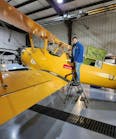7 Technologies That Can Reduce Helicopter Accidents
New aviation technologies can provide a variety of solutions that can directly and indirectly address safety issues related to worldwide civil helicopter operations. In addition, the targeted use of enhanced aviation systems in the cockpit can contribute to accident prevention and an increase in accident survivability.
With this in mind, the European Helicopter Safety Team (EHEST) has worked in partnership with the National Aerospace Laboratory in Amsterdam to study the potential of technologies to mitigate helicopter accident factors.
The study (http://www.ihst.org/Default.aspx?tabid=3045&language=en-US) analyzes accident causes and contributing factors to accidents and links them to technologies that may have prevented the accidents. The “most promising” systems are highlighted in the EHEST study.
Seven technologies related to warning systems and/or improvements in pilot situational awareness are featured below.
Enhanced Ground Proximity Warning System - Risks can be mitigated by installing technological advances such as Enhanced Ground Proximity Warning Systems (also known as Terrain Awareness and Warning System - TAWS). Such systems can provide a warning of fixed, land-based obstacle hazards such as towers.
Laser radar obstacle and terrain avoidance system - Wire strikes have been a major concern for both civil and military helicopters. In addition to wire strike protection devices, there are a number of devices that warn the pilot about the proximity of wires. This specific system uses an eye-safe laser which is mounted on the fuselage to provide the pilot with the information about the surrounding environment using both optical display and aural warning. By using a laser the system can sense objects as thin as wires.
Passive tower-based Obstacle Collision Avoidance System - The Obstacle Collision Avoidance System (OCAS) consists of units located on utility and power line towers and detects all air traffic entering a predefined warning zone and activates warning lights that illuminate the tower. The fact that the OCAS does not require any installation in the helicopter can make it attractive to helicopter operators.
Digital range image algorithms for flight guidance aids for helicopter low-level flight -
Low-altitude and terrain-following flights are needed for both civil and military rotorcraft because carrying out such tasks at low altitude and in poor visibility can be extremely hazardous.
Extensive simulation and flight tests were conducted to develop and test a complete set of algorithms for terrain following or contour flight, and more specifically to improve means of computing a reference Obstacle Contour Line for terrain-following flights. In addition, a wire detection algorithm was designed and simulation tested using real flight test data.
Efficient Numerical Approaches for On-Board Rotorcraft Flight Performance Modelling -
Modern flight systems allow aviators to complete performance and mission planning onboard the aircraft during flight. Previously, aviators planned their performance and mission as a pre-mission exercise using either paper charts and pencil, or using specialized software on a personal computer. Onboard flight performance models answer such questions as: what is the available power, what is the power required to hover or cruise, what is the maximum (flight /hover) weight, what is the maximum flight speed, how much fuel is required or what is the best rate-of-climb that can be achieved?
Radar Altimeter for altitude measurement - A radar altimeter used on an aircraft measures the actual altitude of that aircraft above the terrain by timing how long it takes a beam of radio waves to reflect from the ground and return to the plane. As such, the system provides the pilot with real time and accurate information.
Wire Strike Protection System - A U.S. Army study found that fatalities associated with wire strikes decreased by nearly half after helicopters were equipped with a Wire Strike Protection System, also called wire cutters. The system basically consists of cutters placed on the roof and bottom of the rotorcraft. These can cut through wires in case of collision and thus prevent an accident.
